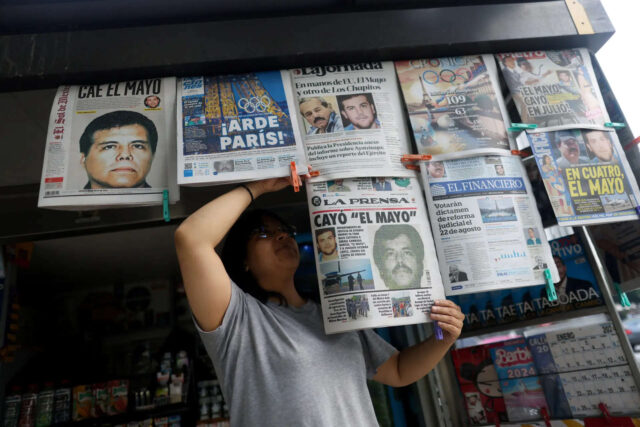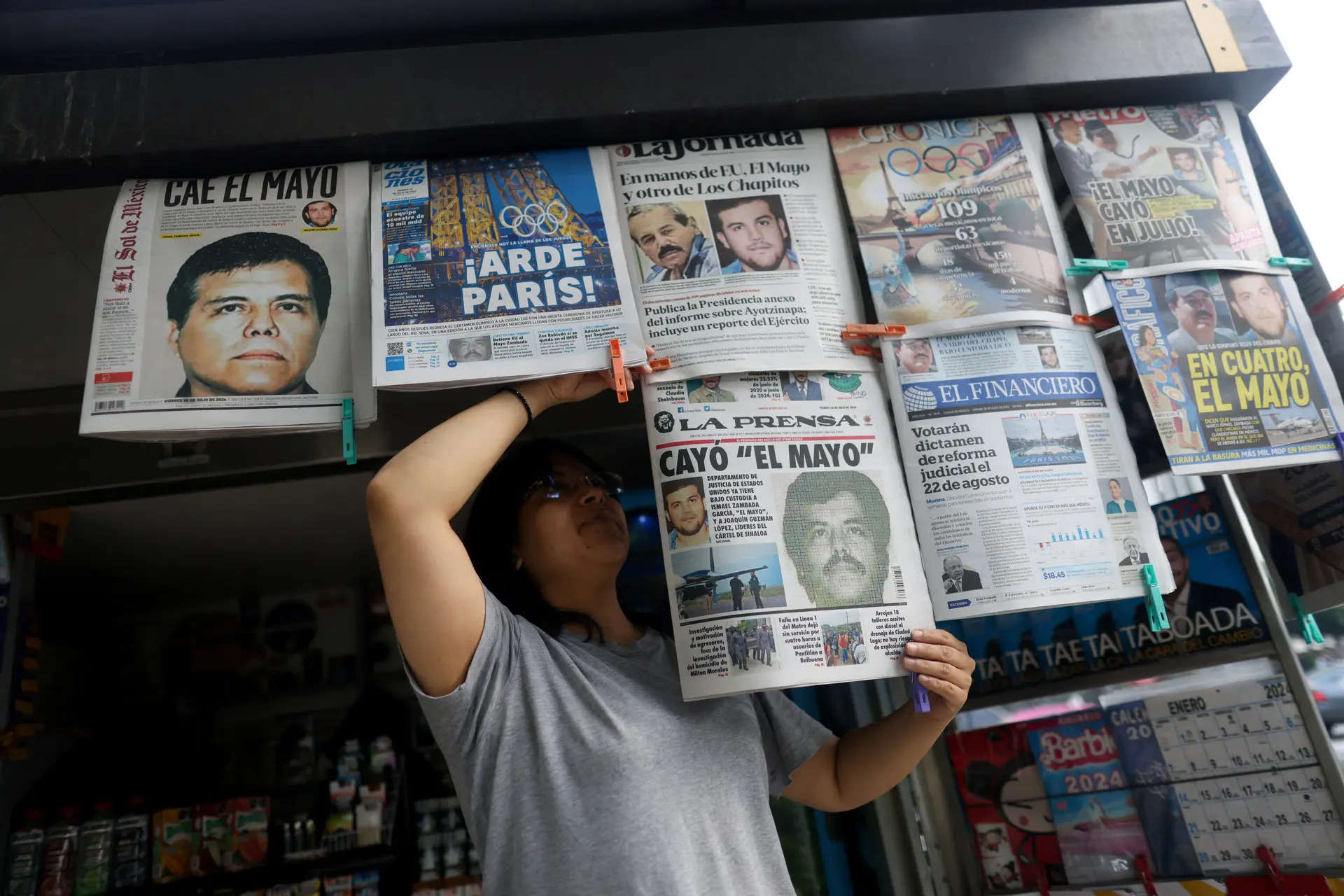
Zambada García, known as El Mayo, had for decades evaded capture by both Mexican and U.S. officials, living a life of luxurious simplicity in the mountains of Sinaloa — despite the $15 million U.S. bounty on his head.
But in the end, U.S. officials said, he was betrayed by an unlikely foe: a son of his closest criminal ally, Joaquín Guzmán Loera, the infamous drug lord known as El Chapo, who is now serving a life sentence in a U.S. federal prison.
El Chapo’s son, Joaquín Guzmán López, tricked Zambada García into boarding the plane, the U.S. officials said, telling him they were going to look at real estate in northern Mexico. The older man had no idea that he was actually en route to Texas, where he would be delivered into the hands of U.S. agents who had long been on his tail.
The dramatic cross-border flight came after years of quiet contact between Guzmán López and a small team of U.S. law enforcement officers in the FBI and Homeland Security Department who had doggedly been chasing him, his three brothers and Zambada García in the wake of Guzmán Loera’s landmark conviction on drug conspiracy charges five years ago. It remains unclear at this point how much the law enforcement officers shaped or directed the events that unfolded Thursday, but they were aware that Zambada García was on the plane as it neared the U.S. border, according to two people familiar with the matter. And in the end, regardless of what role they played, the U.S. agents got what they wanted: They apprehended a hugely important criminal target that had eluded capture and that they had long doubted Mexican officials could — or would — get for them.
Almost immediately, the two arrests unleashed a torrent of questions in Mexico, where the government said that it played no role and that it was unaware anything had taken place until the U.S. Embassy called with the news that Zambada García and Guzmán López were in custody.
Grilled by reporters Friday morning, Mexico’s secretary of security, Rosa Icela Rodríguez, said the government did not know whether the arrest was part of a deal with U.S. prosecutors.
“It’s part of the investigations, whether it was a capture or a surrender,” Rodríguez said. “That’s part of what the U.S. government will have to explain.”
Mexican President Andrés Manuel López Obrador said his administration expected the U.S. government to give a “full report” on how the detentions took place — including whether there was a previous agreement with Zambada García or Guzmán López.
“There is no distrust,” he added. “What we have always asked for is respect.”
There was no formal extradition request for Zambada García, who has been under indictment in the United States for more than two decades, with overlapping drug conspiracy charges in multiple states. And although U.S. officials have been unable to catch him inside Mexico, even with the help of elite troops from the Mexican navy, there have been several near misses in recent years.
By duping Zambada García onto the plane, Guzmán López gave the United States the bounty it had long been after. And, in doing so, he may have also increased his own chances of getting a favorable deal for himself and the brother he is closest to, Ovidio Guzmán López, who was already in U.S. federal custody.
Zambada García waived a personal appearance Friday at a hearing in U.S. District Court in El Paso, entering a plea of not guilty to drug conspiracy charges through a lawyer. He was held in custody pending a detention hearing scheduled for Wednesday.
Guzmán López is expected to appear Tuesday for his own initial hearing in U.S. District Court in Chicago.
U.S. law enforcement agents have maintained a quiet back channel with Guzmán López for some time, one that increased somewhat in frequency after Ovidio was extradited to face trial in Chicago last September, according to three people familiar with his situation.
Although it remains unclear how much effect that outreach had on his decision to trick Zambada García, delivering a prize such as El Mayo to U.S. prosecutors could only help his chances of getting friendly terms in any future plea deal.
U.S. officials had also been quietly negotiating on and off for at least three years with Zambada García about his own potential surrender, although those talks eventually went nowhere.
On Friday, Rodríguez suggested that authorities believed a private Cessna plane carried the two crime bosses out of the country, publicly identifying the pilot as an American citizen named Larry Curtis Parker.
She said the plane took off about 8 a.m. on Thursday. But a U.S. official familiar with the facts of the case said the plane that flew the two men out of Hermosillo was a Beechcraft that had left the airport at about 2 p.m.
Reached by phone Friday afternoon, a man who identified himself as Parker said Mexican officials were wrong in naming him as the pilot who had flown the two men over the border. Parker acknowledged that he flew a small Cessna and said he saw a Beechcraft parked near his own plane at the Hermosillo airport Thursday.
He said he had nothing to do with cartel figures. “I’m just a clean-cut, hardworking American,” Parker said.
An official with Mexico’s security ministry who was not authorized to speak publicly said an investigation would determine whether there was any mistake in identifying the pilot.
The arrest of Zambada García — long considered a godfather in his country’s underworld and one of its shrewdest remaining capos — resounded across Mexico as one of the biggest blows to organized crime in recent years.
“This is the one arrest that can really shake up the Mexican market,” said Vanda Felbab-Brown, a senior fellow at the Brookings Institution and an expert on global drug policy, saying it could provoke “a tremendous amount of violence and instability across the Americas.”
If Zambada García was indeed betrayed, “there is going to be war within Sinaloa,” said Eduardo Guerrero, a security analyst based in Mexico City, generating brutal waves of violence in the coming weeks. A weakened Sinaloa cartel, he said, could also prompt the rival Jalisco New Generation cartel to push into new territory.
On Friday, at least 200 members of the Mexican Special Forces were deployed to Culiacán, the cartel’s stronghold in Sinaloa, to beef up security, the Mexican military said in a statement.
The arrest could also have political implications, some U.S. officials said, particularly if Zambada García decides to cooperate with U.S. authorities and divulge what he knows about corruption in his country.
The Sinaloa cartel has been battered over the past several months by a wave of arrests targeting the upper echelon of the organization.
In May, Néstor Isidro Pérez Salas, who authorities believe is a top assassin for the four Guzmán brothers, was extradited to New York on drug conspiracy charges, part of a sprawling indictment that accuses El Chapo’s sons of being among the world’s most prolific smugglers of fentanyl. Another suspected Sinaloa assassin, Jorge Iván Gastélum Ávila, was extradited last year to stand trial in Washington.
But experts said the arrests were unlikely to make a dent in the flows of fentanyl and other drugs across the border.
“It’s not a fatal blow,” said Valentin Pereda, a professor of criminology at the University of Montreal. “Everybody in Sinaloa mourned the arrest of El Chapo. But at the same time, the organization survived and continued growing.”
“It would take months of really intensive warfare” within the cartel for the world to detect a change in fentanyl trafficking dynamics, Felbab-Brown added. “We’re far away from that moment.”
This article originally appeared in The New York Times.




































